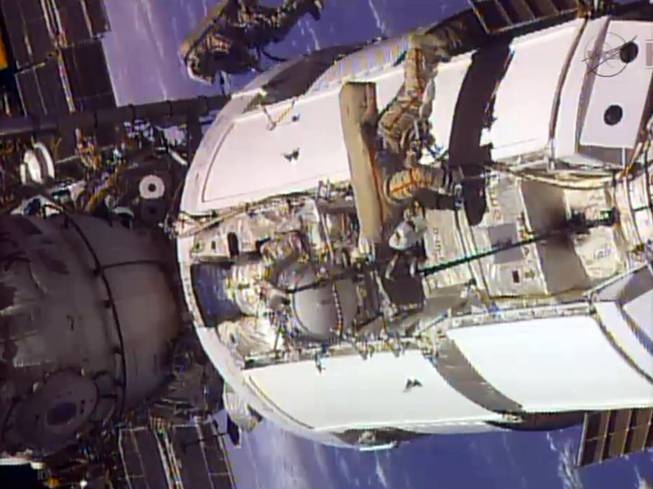
NASA / AP
In this frame grab from video provided by NASA, two Russian flight engineers perform maintenance on the International Space Station, Monday, June 24, 2013. NASA said Dec. 11, 2013, it is looking into a problem with a malfunctioning cooling pump on the International Space Station, but there is no immediate danger to the six crewmen on board. Agency spokesman Kelly Humphries says the problem may eventually be serious, but is not an emergency at the moment.
Published Wednesday, Dec. 11, 2013 | 4:08 p.m.
Updated Wednesday, Dec. 11, 2013 | 8 p.m.
WASHINGTON —NASA said Wednesday it was looking into a problem with a malfunctioning cooling pump on the International Space Station, but there was no immediate danger to the six crewmen on board.
A valve on a pump on one of the station's two external cooling loops shut down because it was too cool Wednesday afternoon, NASA spokesman Bob Jacobs said. He said that at no time was the crew at risk. But some non-critical equipment of the massive orbital outpost were powered down.
"It could be a serious problem, but it's not an emergency," Johnson Space Center spokesman Kelly Humphries said.
Engineers suspect a valve inside the pump was faulty and ground controllers moved electrical power supplies to the other cooling loop, Jacobs said. These loops circulate ammonia outside the station to keep equipment inside and outside cool.
"The station wasn't ever in any danger," Jacobs said.
Jacobs said the crew of two American astronauts, three Russian cosmonauts and a Japanese astronaut were preparing to go to bed as normal, while engineers on the ground tried to troubleshoot the problem. The faulty pump and cooling loop did start up again, he said.
Humphries said it was too early to speculate whether a spacewalk would be needed to fix the problem.
The station commander is cosmonaut Oleg Kotov. Americans Rick Mastracchio and Michael Hopkins, Russians Mikhail Tyurin and Sergey Ryazanaskiy, and Japanese astronaut Koichi Wakata are aboard. The orbital outpost, the size of a football field and weighing nearly 1 million pounds, has been in orbit more than 220 miles above Earth since 1998.

Join the Discussion:
Check this out for a full explanation of our conversion to the LiveFyre commenting system and instructions on how to sign up for an account.
Full comments policy